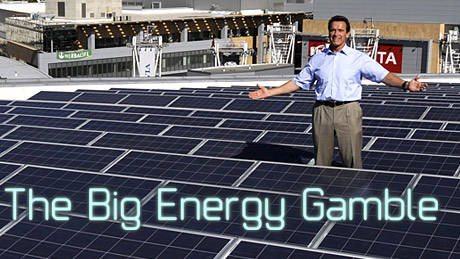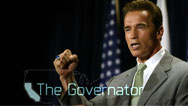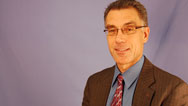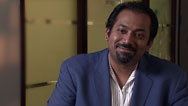
The Big Energy Gamble
Can California's ambitious plan to cut greenhouse gases actually succeed? Airing January 20, 2009 at 9 pm on PBS Aired January 20, 2009 on PBS

Program Description
Transcript
The Big Energy Gamble
PBS Airdate: January 20, 2009
ANNOUNCER:...governor of the great state of California, Arnold Schwarzenegger.
NARRATOR: The man they call "the governator," California's Arnold Schwarzenegger, is waging war.
ARNOLD SCHWARZENEGGER (Governor of California/Film Clip of Press Conference): So we are moving in every direction in order to bring down our greenhouse gas emissions.
NARRATOR: The enemy is global warming, and he wants the rest of the country to follow where he is leading.
ARNOLD SCHWARZENEGGER: California, even though a little tiny spot on the globe, barely can find it, but the power of influence that we have over the rest of the world is an equivalent of a whole continent.
NARRATOR: He plans to slash California's carbon dioxide emissions in a move that could affect people's jobs, homes, even the cars they drive. He promises no one will suffer, but some think he is leading the state towards disaster.
MARLO LEWIS, JR. (Competitive Enterprise Institute): If there were a mandate to cut energy radically, in one particular state, that state would see its economy implode.
NARRATOR: The plan is bold, laying out a whole new energy landscape, with thousands of new wind turbines, solar panels and green industries. It even takes on cars, in a place where the car is king.
Could California serve as a model for national energy policy, or are the risks too great?
VIJAY VAITHEESWARAN (The Economist): There's no question that California is rolling the dice with its energy policies. It is a risk. But the bigger risk, I would say, is the risk of inaction in the face of climate change.
NARRATOR: The Big Energy Gamble, up next on NOVA.
NARRATOR: California: 38 million people live here; it's the most populated state and the eighth largest economy on the planet. But California is at risk from what many believe are the early impacts of global warming.
For the last 10 years, California has been parched by drought and seared by forest fires. Freak weather has destroyed homes and ruined lives.
MAN: There was flames 100-foot high, blowing across the road both directions.
FIREFIGHTER: I told you to get out. You need to get out now!
NARRATOR: And while no one can say for sure global warming is the cause...
WOMAN: Just a lot of mud came down the street... a wall of mud.
NARRATOR: ...climate experts predict the future may hold even more of these extreme weather events because of an increase in greenhouse gasses, especially CO2, emitted when we burn fossil fuels like coal for electricity and gasoline for cars. It's an odorless, colorless gas that traps heat in the Earth's atmosphere. Most scientists say that this extra heat will alter the planet's climate.
STEVEN CHU (United States Secretary of Energy): CO2 is accumulating in the atmosphere faster than we thought it possible. And we're now exceeding the worst-case scenarios, both on the effects of CO2 and climate change and global warming, but also, on the rate at which we're going to get there.
NARRATOR: And the predicted effects of climate change seem especially dire in California: a 50 percent increase in the frequency of drought-induced forest fires; a sharp rise in heat waves and related deaths; millions of acres of coastal land threatened by rising seas; and a steep decline of the Sierra snow pack, the major source of water for California's cities and farms.
But California has something no other state does; its governor, Arnold Schwarzenegger, once a Terminator, is now an eco-warrior.
ARNOLD SCHWARZENEGGER (Film clip from The Terminator): Hasta la vista, baby.
ARNOLD SCHWARZENEGGER: Here's the bottom line. We know that there is global warming, climate change. And we know that we are creating it. I mean, the most respected scientists have made that clear, by the...thousands of scientists have made that clear.
NARRATOR: A former Mr. Universe, turned movie icon, his image is not of a man committed to preserving things.
ARNOLD SCHWARZENEGGER (Speaking to the United Nations): Action, action, action.
NARRATOR: But now, Arnold Schwarzenegger is responsible for one of the most visionary—some might say radical—environmental programs in the world, aimed at reversing climate change.
ARNOLD SCHWARZENEGGER (Speaking to the United Nations): Do not lose hope. I do not believe that doom and gloom and disaster are the only outcomes. California is mobilizing technologically, financially and politically to fight global climate change. Thank you very much. Thank you.
ARNOLD SCHWARZENEGGER: In my heart, I had the will and I had the passion for doing something for the environment.
NARRATOR: For over a hundred years, greenhouse gas emissions have risen unrelentingly. Schwarzenegger's new regulation, called AB 32, is designed to halt and reverse this. He wants to slash predicted emissions by 30 percent by 2020, turning the clock back to 1990 levels. By 2050, he wants a further 80 percent reduction. That would bring emissions back to levels not seen since the early 20th century.
These targets, most scientists say, must be met by the entire world, to avoid the worst effects of global warming. They are the same targets President Obama has proposed. The governor's profound hope is that he is pioneering a plan that the rest of the country, in fact, the whole world, can follow.
ARNOLD SCHWARZENEGGER: I knew that we should not just look at it as this little place and at only the things that we can contribute, but what power we have to push the country, the United States and the whole world forward.
NARRATOR: Schwarzenegger's AB 32 could affect nearly every aspect of people's lives. At least 15 percent of his planned emissions cuts are slated to come from efficiencies in homes and commercial buildings. Another 15 percent will come from changes to how power is generated. And 33 percent, one third, will come from cutting car emissions. The remainder will come from measures like CO2 caps on big industry, and planting new forests to absorb carbon dioxide.
Schwarzenegger has placed himself and California right in the middle of a debate that is raging across the globe. Can global warming be reversed without harming the economy? The governor promises it can.
ARNOLD SCHWARZENEGGER (in The Terminator/Film Clip): Trust me.
ARNOLD SCHWARZENEGGER: I told the people, when I ran for governor, I said, "We're going to protect the economy and the environment simultaneously. No one will have to sacrifice here."
NARRATOR: But there are a lot of people out there who don't believe him. They say that the people of California will pay a price for his green revolution. Far from saving the state, the governor will destroy it.
MARLO LEWIS: Energy prices will go up. There is no doubt about it. You can take that to the bank. I predict that if we implement AB 32, over the next several years, as the increased energy costs kick in, you will begin to see job flight and capital flight from California.
NARRATOR: The current economic climate puts this issue in stark relief. This past year, the state had half a million foreclosures, lost more than 100,000 jobs and declared a fiscal emergency.
Chuck DeVore is a California State assemblyman.
CHUCK DEVORE (California State Assembly Member): It hurts Californians. Poverty and jobs are a big issue. Greenhouse gas emissions are, at this point in time, a fairly theoretical problem. Putting food on the table and having a roof over your head, those are more immediate concerns.
NARRATOR: And that's the issue. Schwarzenegger says you can be green and thrive; his critics say it is impossible.
NARRATOR: As a new administration in Washington maps out a national energy policy, all eyes are set squarely on California. So just how big a gamble is it taking?
The governor starts with one massive advantage: the people of California themselves, people like Ed Begley, Jr.
ED BEGLEY, JR. (Actor): I'm going to go to the grocery store on my hybrid-electric bike. I can pedal, or I can just use the throttle here.
NARRATOR: Ed Begley is the ideal of the modern Californian: energy conscious, environmentally aware and, like the governor, a movie star.
ED BEGLEY: When I first tried solar electric photovoltaics in 1990, I put about a thousand watts on my roof and it worked very well, so I decided to try some more. I put another thousand watts, and then I put another thousand watts.
But often, when the sun is not shining, the wind is blowing. You get a good amount of power in a wind turbine like this. It's a perfect marriage with solar power, clean wind energy.
NARRATOR: His example has inspired his slightly competitive neighbor to embark on a similar path.
Bill Nye, well known as "the Science Guy," spends his free time greening his Studio City home in every way he can.
BILL NYE (Science Educator): Now, this is a hybrid car. I mean, I get over 45 miles to the gallon, it's a great car. But Begley, he's got electric vehicles, all electric, zero emission, and he powers them up with his solar panels...coming after you Begley, coming after you!
This is my rain barrel. This is my solar hot water tank. This is the north side of my solar panel system. I got four kilowatts. Ed's got six.
NARRATOR: It's a whole new way of keeping up with the Joneses.
BILL NYE: Now Begley's got a wind turbine! I don't have one; you know why? Well, it's on order.
NARRATOR: Every house, even Begley and Nye's, has to use some energy. Remember, the governor's aim is to make at least 15 percent of his emissions cuts by improving energy efficiency in private homes and commercial buildings.
ED BEGLEY: You want a refrigerator with the highest Energy Star rating, the same with your microwave, the same with your stove.
NARRATOR: The theory is, the more efficient your house, the less power you'll need, and that means less carbon dioxide in the atmosphere.
ED BEGLEY: One of the biggest-bang-for-your buck items you can have is compact fluorescent lighting. Bill Nye, I don't think has dimmable compact fluorescents.
I'll check on that, but I think I'm ahead of him, yet again, in this key area...dimmable, dimmable...sorry, Bill.
NARRATOR: This friendly competition isn't just socially responsible, it's money in their pockets.
ED BEGLEY: I did it to save the Earth; I did it because of the first Earth Day; I did it for a number of reasons. I quickly learned, the first year, I was saving money doing this cheap and easy stuff.
NARRATOR: Begley and Nye are not just exceptions. California is the most energy-efficient state in the entire U.S.A. In fact, over the last 35 years, as per capita electricity use in the country has soared 50 percent, California has remained flat.
The question is, how much farther can it go? Because one thing becomes clear when you see what Begley and Nye have done...
ED BEGLEY: It's $3,000.
NARRATOR: ...it costs a lot of money.
ED BEGLEY: I just do everything I can, that I can afford, and that's what I do.
NARRATOR: But to hit the governor's 2020 targets for emissions reductions, most people will not have to go to these extremes. Sealing leaks in ducts and windows, adding insulation and changing light bulbs would be enough. The California Energy Commission says the total cost to a typical household could be as little as $1,500.
Some 70 percent of the efficiency target will be achieved in commercial properties.
In the past, efficiency has been a safe investment, with a guaranteed payback. Over the last 35 years, efficiency improvements have saved Californians over $50 billion. But what about the people who can't even afford the minimum improvements? People like many in the community of Richmond, California.
VAN JONES (Green for All): This is Richmond, California. You've got extremely low-income people. You've got, you know, crime, violence, a lot of economic desperation, you know. And you can't be in a neighborhood like this talking about "let's save the polar bears." You know, they're not, they're not going to feel you.
NARRATOR: Van Jones is an environmental activist. Today he's in Richmond, a low-income area between San Francisco and Sacramento. And he sees one basic problem: the people and businesses here just don't have the money to buy energy-saving materials.
VAN JONES: You know, you got businesses like this one. I guarantee you they've got old refrigeration that's using way too much energy. I guarantee you, you know, those windows are leaking a lot of energy. There are probably 30 or 40 percent improvements you could do just right here. You do that in all of these little small businesses, you can make a big difference. But they can't afford it.
NARRATOR: Willie Mae Payne knows just what he means. She has every incentive to save energy. Those leaky window frames cost her too much in lost heat.
WILLIE MAE PAYNE (Richmond, California Resident): My energy bills are high. They run, approximately $250 or more per month, especially during the winter months.
NARRATOR: But she is caught in a classic poverty trap. She needs to save money to upgrade her windows, but until she upgrades her windows, she can't save any money.
WILLIE MAE PAYNE: People like me, living in older homes and neighborhoods like this, would love to do better for themselves. I can speak for myself. Personally, I would absolutely, today, change my windows and do anything necessary to make it better here. However, I am not financially able and neither are many of my neighbors.
NARRATOR: And this is where the governor's hopes for making savings in the residential sector may prove difficult. There are 12 million low-income people in the state of California. Without bringing them along, Jones warns that the whole plan will run into trouble.
VAN JONES: There's no way to beat global warming without weatherizing millions and millions of buildings. California will fail if it leaves out the majority of the state. And the majority of people in this state are people of color, low-income people, working people, who, right now, don't feel a part of this. They feel like it's just an eco-elite agenda for, maybe, the Hollywood crowd. Most communities like Richmond are not even involved.
NARRATOR: For now. But over the next 12 years, the governor plans to subsidize efficiency improvements for almost every low-income household in California, at a cost of some $4 billion.
It means he should hit his 15 percent efficiency target by 2020, though at a price. But to hit the long-term 2050 goal of an 80 percent reduction in CO2 emissions, the amount spent on subsidies will be much greater, unless a revolution can come from a place like this: California's Lawrence Berkeley National Laboratory.
NOVA interviewed President Obama's Energy Secretary, Steven Chu, while he was director of the lab.
STEVEN CHU:The wonderful thing about California is that the entire state is engaged on the climate change problem. California has, over the last several decades, shown a real leadership position in energy efficiency. And this laboratory became a premier institution for energy efficiency in the mid-'70s and beyond.
NARRATOR: Triple-pane windows with insulating Low-E coatings, automatic shades, daylight simulation software, advanced passive cooling: new technology offers hope that California can meet its aggressive efficiency targets.
STEVEN CHU:Having these very aggressive goals is actually a very good stimulus. I have a lab full of scientists that believe in these goals and they want to deliver.
NARRATOR: But delivering these innovations will take years. In the meantime, over the next 12 years, for efficiency improvements to homes and commercial buildings, Californians face upfront costs of some $50 billion, although the eventual payback could be even bigger.
But a larger issue is where all of California's energy will come from in the first place. The governor wants to get 15 percent of his emissions cuts from power generation by the year 2020. With California's insatiable need for energy, is it possible?
NARRATOR: All things that make California what it is, the glitz, the glamour, the wealth, the businesses—big, small and high tech—all of this devours energy.
MARLO LEWIS: Energy is the lifeblood of a modern economy, and electricity, in particular, is becoming more important, as we as we move further and further into the information age, the digital economy. It all runs on electrons.
NARRATOR: These electrons are shipped around the state by a complex network of wires and transmission lines known as "the grid." It's operated from central control rooms, like this one in Rosemead, California. From here, engineers take power from different sources and direct it where it's needed.
But when electricity comes from burning fossil fuels like coal, carbon dioxide is the inevitable byproduct. The reason is that, like all fossil fuels, coal consists of hydrocarbons, long chains of hydrogen and carbon atoms. When burned, the carbon separates from the hydrogen and combines with oxygen to form carbon dioxide. The more carbon, the more carbon dioxide is released, and coal has the most carbon of any fossil fuel.
So, here, the governor is acting at his boldest. Sixteen percent of California's electricity now comes from coal. He plans to scrap all of it, and replace most of it with renewable energy. That's sources like wind and solar power, sources that never run out and don't directly produce a single molecule of CO2.
Right now, California gets 12 percent of its power from renewables. The governor's plan is to raise that to 20 percent in just two years.
ARNOLD SCHWARZENEGGER: Let me tell you something. We can make our goal and reach our goal of renewables by the year 2010, easily.
NARRATOR: By 2020, he hopes to get to 33 percent. To make this possible, there are ambitious plans to put solar panels on a million roofs and on 1,500 acres of commercial buildings.
But unlike efficiency improvements, solar panels are out of reach for most homeowners. Even after a tax rebate, Bill Nye's cost $32,000. The most visible renewable energy source is also the most expensive. And one million solar roofs will yield just one percent of the necessary emissions cuts.
Here's how solar can produce power plant levels of energy: called "solar thermal," huge tracts of mirrors focus the Sun's rays on tubes of moving oil, to make steam. But for solar to be a real player, dozens of plants like this will have to be built in California. So far, the state has only one in operation.
Still, the governor has high hopes for renewables. And there is no doubt that when it comes to wind and sun, California is blessed.
The Tehachapi Pass on the edge of the Mojave Desert is a monument to renewables. There are over 3,000 wind turbines here, and plans for solar thermal plants are underway.
DANIEL M. KAMMEN (University of California, Berkeley): Places like this are just exceptional resources. There's solar power, there's wind power. There's the ability and the space to invest in big projects. What's really remarkable is that these types of places we thought of as high deserts, but in fact they're a remarkable place and an opportunity to start a clean energy revolution.
NARRATOR: Wind turbines work by rotating a shaft just behind large blades. The main shaft turns a gearbox which ratchets up the speed for a generator to produce electricity. The basic rule is the longer the blade, the more power produced, so much hope is being invested in a new, super-sized generation of turbines.
DANIEL KAMMEN: The technologies have evolved dramatically. The wind turbines being installed now are much larger, much lower cost, higher reliability. What's going on now is a huge rebirth in the industry. In some of the areas, like here, this has become a least-cost way to produce power.
NARRATOR: In the Tehachapi, Oak Creek Energy has installed the first of 1,500 new turbines that could replace the capacity of nine coal power plants, if certain problems can be solved.
The Tehachapi Pass is 80 miles from L.A. Long transmission lines are needed to link it to the city, and a lot of people are opposed to them.
ARNOLD SCHWARZENEGGER: Then you have environmentalists that say, "We would love you to build plants in the Mojave Desert. But the only thing is, when it comes to building the transmission lines to get it on the grid, no." It's this crazy stuff that you have environmental regulations holding up environmental progress. And that's what we are suffering under right now.
NARRATOR: It took six years to get permission to link these new turbines to L.A., and the lines aren't even up yet. At this rate of progress, it would be very difficult for the governor hit his target for renewables: 33 percent by 2020.
But that is not the only problem. Coal can be burnt to release energy when you need it, but what do you do if the sun doesn't shine and the wind doesn't blow?
DANIEL KAMMEN: Renewables aren't the easy we're-just-going-to-do-it solution. There are issues. One of the big issues is that for solar and wind, in particular, they are intermittent. They're on some of the time, off other times, and it's not consistent. You cannot always predict it.
NARRATOR: But grid managers have to predict it. They need power on demand. And when they can't get it, it raises one alarming specter.
REPORTER 1: Minutes after the power went out in Aliso Viejo there was the sound of screeching tires and crumpled cars.
NARRATOR: With an aging grid and a shortage of reserve power, blackouts have plagued California for years.
REPORTER 2: We're talking 10, 20, 30 miles from downtown Los Angeles, possibly, with people without power.
PHARMACIST: We cannot get on our computer. We cannot process prescriptions. We cannot call doctors for refills.
NARRATOR: To eliminate the risk of blackouts, as renewable energy increases beyond 20 percent, it will be necessary to come up with a cost-effective technology to store power.
STEVEN CHU:With renewables, we don't know how to store the energy. If we want to get 20, 30 percent of our electricity generation from variable sources like wind or solar energy, we need to solve the energy storage problem.
NARRATOR: There is a backup plan: build new natural gas plants. Forty-five percent of the state's electricity comes from natural gas, but natural gas still emits CO2—about half as much as coal. If the state were to build more of these plants, it would be stuck with these emissions for decades, as well as compromise the further development of renewables.
So the governor has another possibility in mind.
ARNOLD SCHWARZENEGGER: I want people to look at nuclear power. There is ways of going where we can revisit it. I'm not saying build it, because I'm not running the state by myself. What I'm saying is, "let us all discuss it."
NARRATOR: To its advocates, nuclear power is the perfect alternative.
CHUCK DEVORE: Nuclear power produces the most amount of electricity for the smallest amount of global greenhouse gas emissions of any form of energy. And it's the only thing that's scalable and large enough that you can power modern society on.
NARRATOR: The nuclear fuel rods sit in water; a fission reaction heats it up; this produces steam, and the steam turns turbines that generate electricity, all without emitting any carbon dioxide. California now has four reactors producing 15 percent of its power, but there's an obstacle to building any more.
DANIEL KAMMEN: California and nuclear power have a very complicated relationship, starting with the fact that it's just plain illegal to build nuclear here. So even if you wanted to build nuclear, you're going to have to change the law.
NARRATOR: Fears of radioactivity go deep in California. So, for the time being, there's a ban on building new reactors in this state, at least until the federal government approves a permanent storage site for nuclear waste.
CHUCK DEVORE: The biggest challenge with AB 32 is that it's physically impossible, unless you lift the state's obsolete 32-year ban on the construction of modern, safe and efficient nuclear power plants. You just can't do it without that.
NARRATOR: Chuck DeVore is working in the California legislature to overturn this ban. And others feel nuclear, while expensive, could provide a crucial bridge of reliable power while the technological problems of renewables are figured out.
STEVEN CHU:I have to say, I'd rather see renewed investment in nuclear power plant generation of electricity in this century, than to build more coal plants. There's no question in my mind, that's the lesser of the two evils.
NARRATOR: But whatever the solution, whatever the mix of nuclear, natural gas and renewables California winds up with, one thing is virtually certain, electricity will cost more than it does now.
VIJAY VAITHEESWARAN: The concern about rising prices is a legitimate one, but, to me, that's no crisis. We may well need to enter a world of rising apparent energy prices.
NARRATOR: The state's public utilities commission estimates the shift to renewables over the next 12 years could mean as much as $60 billion in additional costs. But could such a cloud over the economy have a silver lining?
STEVEN CHU:When people say that the price of energy would go up, is that possible? Yes, absolutely possible, probable. However, the cost of electricity has stimulated a lot of innovation, and the United States should realize this as a business opportunity. We have incredible intellectual capital in the United States. Why don't we say, "We can go find the solutions, and, not only that, we can export it to the rest of the world?"
NARRATOR: That's exactly what the governor envisions: energy technology as a whole new industry employing huge numbers of people. And it's already starting to happen in California.
This Silicon Valley company, Nanosolar, has attracted an investment of $500 million to make a new generation of solar panels. Its investors are betting on one thing...
MARTIN ROSCHEISEN (Nanosolar, Inc.): ...the sheer size of the market. Electricity's a trillion dollar industry where, even if we capture a percentage of that, it's a huge business.
NARRATOR: Traditional solar panels are made from semi-conducting silicon cells. It's a delicate and complex industrial process. Nanosolar is one of the new "thin film" solar companies. They manufacture their panels not from fragile silicon wafers, but from ink.
JACOB WOODRUFF (Nanosolar, Inc.): Here at Nanosolar, we start with a nanoparticle ink. It is made up of Copper Indium Gallium diSelenide, or CIGS, for short.
NARRATOR: The liquid ink is deposited in micron-thin layers onto metal foil then heated to convert it into a semiconductor.
JACOB WOODRUFF: This is what you end up with. This is the final product. The dark area is the ink, or the semiconductor material, and on the back, here, the metal foil that we started with. You see that it's very thin, it's flexible and you're creating electricity.
NARRATOR: The result: a solar cell that's nearly as efficient as silicon and a lot cheaper. It's like printing a newspaper, a very long newspaper.
MARTIN ROSCHEISEN: This tool produces rolls that are one mile long, and we produce many rolls of those per day. And that's a gigawatt of power, of, basically, a nuclear power plant's worth of power, per year.
NARRATOR: Right now, this thin film is covered with thick glass sheets. The company has to guarantee buyers that this new material will last as long as silicon panels. The glass adds expense but protects the film from the elements. As a result, these panels aren't as cheap as they could be. Still, they're sold out for the next three years, and there are many potential clients. Even just down the road, in Silicon Valley, Google has already invested in solar to power its large campus and save money on electric bills.
BILL WEIHL (Google, Inc.): We installed these panels for several reasons. One of them was to help the environment, but the other is to save money. These panels will actually pay for themselves in about seven and a half years. After seven and a half years, we're getting what's essentially free electricity, from these panels. And they'll continue to generate electricity for, you know, 25 to 30 years.
NARRATOR: Another company, California Steel Industries, is investing $70 million to replace this old furnace with a new, more efficient one. It's creating new jobs by building the furnace on site. It's all part of a philosophy that sees green technologies as good for the environment and for the economy, as well.
ARNOLD SCHWARZENEGGER: The Wall Street Journal said that we are experiencing a new gold rush in California because of technologies and companies exploding all over the state. And we are making already $10 billion on green clean technology. And by the year 2010, we are going to make $20 billion. And yes, that's where the action is.
NARRATOR: But there has been no gold rush for Jim and Myra Malkiewicz. Their family has been in the mattress business for decades, but with the increasing costs of materials, times are very tough.
JIM MALKIEWICZ (Wickline Bedding Company): My father's been in the business for 50 years. He's never seen it this difficult. And margins are shrinking: the cost of fuel is going up, the cost of foam is going up. In just a seven-month period we've had four price increases on polyurethane foam—which we use, obviously, a lot in our mattresses—totaling 60 percent, 60 percent. That's just one component. It's gone across the board.
NARRATOR: The vicious pincer of higher costs at a time of recession has devastated their profit margins. They're down to just three percent. For Jim and Myra and their 60 employees, the prospect of a large hike in electricity rates is terrifying.
JIM MALKIEWICZ: Let's add these costs up: let's say we're spending $4,000 a month on energy; that's $50,000 a year. Let's say we go up by $1,000 a month. That's an additional $12,000 that you're spending that comes out of the bottom line. Well, in some cases, that's somebody's employment. The question becomes, "Can you survive these bad credit markets, the tight money? Can you survive the bigger costs in gas, fuel, electricity?
NARRATOR: What is abundantly clear to Jim and Myra is that what applies to Google or California Steel just isn't an option for the small businesses that employ half of all working Californians. Investing in more efficient equipment is simply beyond them.
MYRA MALKIEWICZ (Wickline Bedding Company): The state really hasn't talked to a lot of small business owners to find out what this is going to mean to us. A payback in 10 years, in 12 years, that's too long for a small business like ours. We need, we need to see it right away.
NARRATOR: So great is the fear of the future for Jim and Myra, who have lived in California for decades, that they are contemplating leaving the state.
MYRA MALKIEWICZ: It's not easy to remain a businessperson in California. You think about, you know, "I could go over to Phoenix."
NARRATOR: Arnold Schwarzenegger's gamble is that there will be fewer Jim-and-Myras and more success stories. But California has lost 400,000 manufacturing jobs in the last eight years, and his critics fear that a clean energy future means more of the same.
VIJAY VAITHEESWARAN: Sure, there'll be some job losses. But then again, if clean technologies take off, there might be a boom in windmills or renewables, so I don't think it's a zero-sum game.
NARRATOR: Here's an example of a new opportunity for workers like Rodney Lee, who entered a training program to learn how to install solar panels.
RODNEY LEE (Solar Richmond Graduate): Before I entered the program, I was recently laid off. I had been out of work for about three months, and I felt, at the time, I needed to get an edge and try to rejoin the workforce. As far as I look at it, I think this is the new dot-com, green jobs.
NARRATOR: Now, Rodney is helping train new recruits.
SOLAR RICHMOND TRAINEE: What does that start out with, your hourly wages?
RODNEY LEE:Starting rate for, maybe, a junior installer? Maybe $15 up to $18.
NARRATOR: Although they may not pay as much as the old manufacturing jobs, these jobs won't be outsourced. These super-sized wind turbines were built in Iowa, by Clipper Windpower, a California-based company. It's often cheaper to build big turbines here, than to ship them from overseas.
VAN JONES: We have flat roofs like this from sea to shining sea. This is our Saudi Arabia, right here. These are the jobs of the future. That's the genius of the green economy: it creates more opportunities than the pollution-based economy, not less, more economic opportunity.
NARRATOR: Clearly renewables could bring growth and jobs to California, but both the technological and financial challenges are very real. Still, everyone agrees that none of these compare to the challenges the state will face when it comes to the most ambitious of Schwarzenegger's plans, because, here, the governor is taking on the car.
ARCHIVAL FOOTAGE: The state has to build and maintain 14,000 miles of highway for over 2,000,000 California cars alone.
NARRATOR: California was built on the car. Today, there are over 24 million of them on the road. It's the biggest car market in the U.S.A., and one of its biggest selling models is the S.U.V. Even the governor loves them big.
ARNOLD SCHWARZENEGGER (Film Clip of Press Conference): I saw 50 Hummers. I looked over there, I stopped my car, and I said, "I got to have this car."
NARRATOR: But Schwarzenegger needs to convince Californians to resist the lure of such gas guzzlers, because he plans to achieve the biggest part of his reduction—over 33 percent of his total target—by slashing car emissions. It won't be easy.
DANIEL KAMMEN: Cars are a problem. There's not many ways you can avoid that. California is very car-intensive. We have people who drive from one end of the mall to the other end. It's a real issue. California has got the biggest chunk of its greenhouse gas emissions from vehicles of any state. And private car ownership is continuing to rise.
NARRATOR: Over the years, no one has sold more of these cars than Cal Worthington.
CAR CUSTOMER: I'm trying to find a car that we, that my wife likes.
NARRATOR: Cal is a true industry legend because he knows exactly what his customers want.
CAL WORTHINGTON (The Worthington Dealership Group): How about a used S.U.V.?
You know this is the biggest car market in the world, right here in California. And, of course, the obvious reason is people do have to get around, and that's the only way you can get around.
NARRATOR: The recent dramatic spikes in gas have not soured the appetite for the S.U.V.
CAL WORTHINGTON: We find that the used S.U.V.s are selling better than used cars right now. It's just in our heritage, wanting a big car.
TOM AUSTIN (Sierra Research, Inc.): Regulators tend to think of automobiles as an appliance. That's not what they are to most people. To some people they are the most important possession in their life.
NARRATOR: Cars are politically sensitive territory, so, here, Schwarzenegger is talking the language of caution.
ARNOLD SCHWARZENEGGER: We have to slowly change, because, when I came over to this country 40 years ago, this state was celebrating its freeways. You have your car, and you decide where to go because it is a free way. We've got to re-educate people and got to slowly move them in the other direction.
NARRATOR: But what other direction? There's one that Californians have been hesitant to explore, but the governor is an advocate.
ARNOLD SCHWARZENEGGER: Let's use a little bit more mass transit. Let's use high-speed rail.
NARRATOR: But the governor knows this can't be the entire answer to the car problem. Mass transit accounts for less than one percent of his emissions cuts. Instead, his plan is to cut emissions by making people use less gas, effectively raising average fuel efficiency for new vehicles from 25 miles per gallon to 44, by 2020.
That has put the focus onto one particular kind of car, the hybrid. Like a conventional car, a hybrid runs on gas, it just does more with it. Its engine not only powers the car, it charges a battery. The battery also charges when the driver hits the brake.
Because it recaptures energy that regular cars throw away, a hybrid gets more miles per gallon. This hybrid, the Prius, averages 50 and emits 35 percent less CO2 than a similar-sized car.
VIJAY VAITHEESWARAN: The hybrid part is a no-brainer. A hybrid just makes any engine more efficient. Frankly, almost all the cars of the future, whatever fuel they use, are going to use hybrid technology because it's just more efficient.
NARRATOR: There are more hybrids in California than any other state. To many, it is a religion. And this is their temple, the Luscious Garage of San Francisco.
CAROLYN COQUILLETTE (Luscious Garage): Why don't you come in now, and I'll take a peek at it.
NARRATOR: Carolyn Coquillette is owner and lead technician at Luscious.
CAROLYN COQUILLETTE: We wanted to use the hybrid car as the inspiration for the actual business itself. So we were trying to be high tech, cutting edge and environmentally responsible.
NARRATOR: The most cutting-edge work here involves converting hybrids to plug-ins.
CAROLYN COQUILLETTE: So, this is the first car we converted for money. And you can see, this is a finished product. It's plugging into the wall, charging up right now.
NARRATOR: Like a hybrid, the plug-in has a full-size gas tank. It also has extra batteries hidden in a storage chamber beneath the trunk that can be charged by plugging into an ordinary outlet. It means you can travel short distances, up to 40 miles, on electricity.
CAROLYN COQUILLETTE: Basically, if you can do most of your trips within those short distances and you can recharge between trips, you might not have to use any gasoline at all; I mean indefinitely.
VIJAY VAITHEESWARAN: The plug-in part is the genius behind it. It means the first 30, 40 miles of your drive can be on electricity. What's great about that is most Americans only drive 25 miles a day.
NARRATOR: G.M., Ford, Toyota and other manufacturers have all announced plans to produce these cars of the future.
Ed Begley has an all-electric car that plugs in. And at Google they have a fleet of 10 plug-ins. They are the centerpiece of a vision of the future that really is revolutionary, a car that runs on the energy of the sun.
Google has solar panels on top of one of its parking lots. The cars charge up while employees are at work. Southern California Edison is testing a similar setup.
And if the sun's not shining? Well, in California the wind still blows at night.
VIJAY VAITHEESWARAN: I think the endgame for energy is the convergence of automobiles and electricity: these two magnificent but dinosauric industries that have been apart since the days of Henry Ford and Thomas Edison. And the key technology bringing them together is the electric car. That is the plug-in, hybrid, electrified vehicle.
NARRATOR: It is a compelling vision, a place where people drive plug-in cars powered by the sun and the wind, no emissions, everything clean.
But reaching this by 2020, the target set for the governor's 33-percent cut from car emissions, will be very difficult. Of the 24 million cars driven in California, less than two percent of them are hybrids. By 2020 he would need millions of hybrids on the road, or millions of plug-ins.
The problem? Cost. Right now a hybrid is at least $5,000 more expensive than an equivalently-sized conventional car. A plug-in is at least $10,000 more. Federal tax credits do exist, but the extra cost discourages many people.
TOM AUSTIN: There've been a lot of studies about what people are willing to pay for higher fuel economy. And the consensus is that if a new car buyer can't make back the increased cost for higher fuel economy in about three years, they're not interested.
NARRATOR: But will they be interested if new technologies can bring the cost down? There's currently research being done to make the internal combustion engine more efficient and to create lighter and cheaper batteries that can store more energy. Innovations like these, ultimately, will reduce CO2 emissions and costs.
ARNOLD SCHWARZENEGGER: Let's work together with the think tanks, with the universities, with the scientists and everyone. Let's figure out the new technology, because, I always say that technology will save the environment.
NARRATOR: But technology alone isn't enough. Historically, it's regulation, like the new auto emissions standards California is proposing, that will achieve real reductions.
STEVEN CHU: As long as the lawyers and the lobbyists are part of this, progress isn't going to be made. As soon as both sides of the aisle, the Republicans and the Democrats, say it's going to happen, it's then assigned to the engineers. And then, progress is made.
NARRATOR: So this is the full extent of the governor's gamble. Of all the AB 32 initiatives, reducing CO2 emissions from cars presents the greatest challenge and, perhaps, the greatest opportunity.
Achieving efficiencies in homes and buildings seems more attainable, but only with huge up-front costs and subsidies. California is already moving forward and investing heavily in that direction.
Renewable power generation is the final challenge. Several companies have applied for permits to build solar thermal plants and wind farms. Still, solving problems like energy storage and a new transmission infrastructure will require a vast investment of scientific capital. But here, if the new Secretary of Energy's intentions are any guide to his actions, California can look to the federal government for help.
STEVEN CHU:Take this as a challenge. We need science to find carbon-free sources of energy. If we're going to get a solution to the climate problem, the energy problem, where it will not cripple our economy, science has to deliver those answers.
NARRATOR: After years of being out front and alone, Schwarzenegger seems to be finding support in Washington for his vision that developing a green economy, far from being a drain, may be a path to prosperity. And if that happens, California, for all the risks it's taking, could be in the lead.
VAN JONES: So California is willing, now, to go out in front. There's some short-term costs, but the long-term payoff is going to be tremendous for California and for all Californians.
NARRATOR: Whether the promise of the green economy materializes, whether the costs and benefits balance out for most people, there's one important question: in the face of climate change, do we have a choice?
VIJAY VAITHEESWARAN: California is going to get things wrong. But here's the real lesson of California, we must continue to provide the prosperity for our people in a lifestyle that Americans have come to expect. But at the same time, we also must tackle climate change, because not doing anything is also a choice.
NARRATOR: And left unchecked, no one knows for sure what the ultimate cost of climate change may be.
ARNOLD SCHWARZENEGGER: I don't think that the rest of the country has time to wait and to see if we are successful. This country has no more time.
NARRATOR: On NOVA's Energy Web site, follow one of our staff members as she tries to reduce her own energy use. Also, hear more from the governor, a scientist and a skeptic. Find it on PBS.org.
Broadcast Credits
The Big Energy Gamble
- Written and Produced by
- Larry Klein
- Consulting Producer
- Matthew Barrett
- Produced by
- Cass Sapir
- Edited by
- David Fairhead
Nathan Hendrie
Doug Quade - Narrated by
- Jay O. Sanders
- Camera
- Bob Elfstrom
Gordon Brown
Michael Chin
Joseph Friedman
Tom Kaufman
Peter Krajewski - Sound Recordists
- Ray Day
Jeff Adelman
Doug Dunderdale
Charlie Macarone
Gabriel Monts
Charles Rohr
Paul Rusnak - Gaffers
- Andrew Eckmann
John South - Jib Operator
- Joe Victoria
- Production Assistants
- Marshall Potter
Brandon DePaolo
Rich Enriquez
Daniel Gorrell
Austin Smoak - Aerial Camera Operator
- Carston Bell
- Music
- John Dutton
Tom Martin
Michael Bacon - Animation
- Sputnik Animation
James LaPlante - Online Editor and Colorist
- Michael H. Amundson
- Audio Mix
- Jim Sullivan
- Archival Material
- Angel City Air
BBC Motion Gallery
Clipper Windpower, Inc.
Corbis
FootageBank HD
Getty Images
ITN Archive
REpower Systems AG, Germany
UN Visual Library, Department of Public Information - Special Thanks
- Doug Arent
Marilyn Brown
Ralph Cavanagh
Ed Duggan
Niki Fenwick
Brett Guge
Michael Honig
Ed Kjaer
Paul Klein
Henry Lee
Richard Newell
Orchard Hotel, San Francisco
Dan Reicher
Gene Rodrigues
David Roland-Holst
Joseph Romm
Arthur H. Rosenfeld
Todd Schatzki
Stephen Selkowitz
Abbe Serphos
Harley Shaiken
David Thurm
Bill Weihl
Monet Zulpo-Dane - NOVA Series Graphics
- yU + co.
- NOVA Theme Music
- Walter Werzowa
John Luker
Musikvergnuegen, Inc. - Additional NOVA Theme Music
- Ray Loring
Rob Morsberger - Closed Captioning
- The Caption Center
- Publicity
- Carole McFall
Eileen Campion
Victoria Louie
Karinna Sjo-Gaber
Karen Laverty - Marketing
- Steve Sears
- Researcher
- Kate Becker
- Senior Researcher
- Gaia Remerowski
- Production Coordinator
- Linda Callahan
- Paralegal
- Sarah Erlandson
- Talent Relations
- Scott Kardel, Esq.
Janice Flood - Legal Counsel
- Susan Rosen
- Production Assistant
- Ryan Murdock
- Post Production Assistant
- Darcy Forlenza
- Associate Producer, Post Production
- Patrick Carey
- Post Production Supervisor
- Regina O'Toole
- Post Production Editors
- Rebecca Nieto
Jason York - Post Production Manager
- Nathan Gunner
- Compliance Manager
- Linzy Emery
- Development Producer
- Pamela Rosenstein
- Supervising Producer
- Stephen Sweigart
- Business Manager
- Joseph P. Tracy
- Senior Producer and Project Director
- Lisa Mirowitz
- Coordinating Producer
- Laurie Cahalane
- Senior Science Editor
- Evan Hadingham
- Senior Series Producer
- Melanie Wallace
- Managing Director
- Alan Ritsko
- Senior Executive Producer
- Paula S. Apsell
A NOVA Production by Production Group, Inc. for WGBH Boston
© 2009 WGBH Educational Foundation
All rights reserved
The Big Energy Gamble homepage
- Image: (Arnold Schwarzenegger on rooftop)
- © Andrew Gombert/epa/Corbis
Participants
- Ed Begley, JR.
- Actor www.edbegley.com/biography
- Steven Chu
- U.S. Secretary of Energy www.osti.gov/accomplishments/chu.html
- Chuck Devore
- California State Assemblyman arc.asm.ca.gov/member/70/?p=bio
- Van Jones III
- Green For All www.greenforall.org/about-us/staff
- Daniel M. Kammen
- University of California, Berkeley
- Marlo Lewis, JR.
- Competitive Enterprise Institute cei.org/people/marlo-lewis-jr
- Jim Malkiewicz
- Wickline Bedding Company www.wicklinebedding.com/
- Bill Nye
- Science Educator www.billnye.com/
- Willie Mae Payne
- Richmond, California
- Martin Roscheisen
- Nanosolar www.nanosolar.com/team.htm
- Arnold Schwarzenegger
- Governor of California gov.ca.gov/
- Vijay Vaitheeswaran
- The Economist www.vijaytothepeople.com/
- Bill Weihl
- Google research.google.com/pubs/author3525.html
- Jacob Woodruff
- Nanosolar www.nanosolar.com/index.html
Preview
Full Program | 52:27
Full program available for streaming through
Watch Online
Full program available
Soon










